Continuing on from our previous post about ‘6 things not to do when hiking in Ireland (Part 1)‘, we’re continuing this series in with 9 more examples of errors, mistakes and mishaps made by myself along the hiking trails of Ireland and abroad. Again, feel free to have a laugh at my expense as you hopefully learn a few good tips of what not to do on hikes in Ireland.
And remember to check back for the last 8 tips in part 3 of this series.
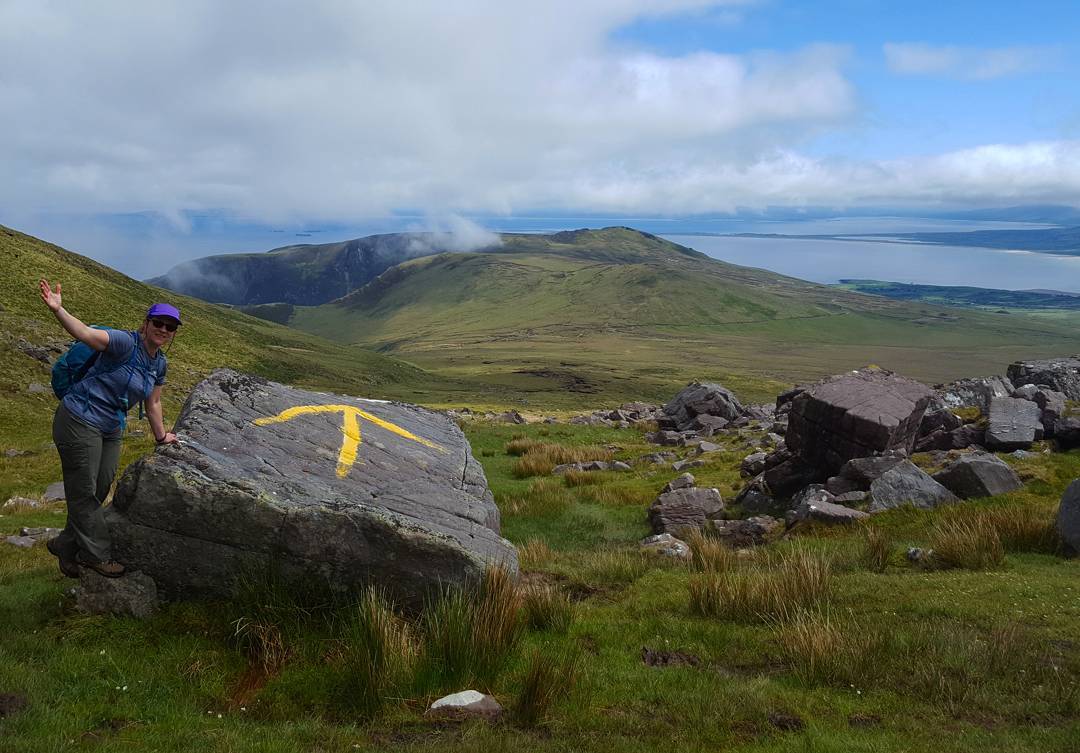
Planning your trip hike in Ireland? Check out hillwalktours.com
Misread your map and surrounds
On a journey up the side of Ben Baun, the highest mountain in Connemara’s Twelve Bens mountain range, we once forgot to take into account the date that our map was created. Although many objects on your map will never let you down or lie to you – and by this I mean they will always be there, like mountains, the coastline, etc. – some things do change much more quickly than you think. On this particular occasion, we’d forgotten that the pine plantations you see around you in real life rarely correspond exactly to what’s depicted on your map. Unless your map was created very recently, pine plantations are especially troublesome if you are using them to get a quick bearing, like we did on that day in Connemara.
This is because such tracts are every few years felled and replanted, sometimes with massive changes to their appearance on the ground. For ourselves, the difference was so large that the expanse of pine forest we saw to our northwest was actually an entire kilometre closer than the one marked on our map. Given that this younger plantation had grown to the height of our twenty year old map’s long since harvested forest, we took a turn to the southwest much too soon and attempted to ascend Ben Baun via the wrong re-entrant. At first this seemed fine, but about half way up it became evidently clear that the steep channel we were following upwards was in fact quite different from the one we thought we were tracking on our map.
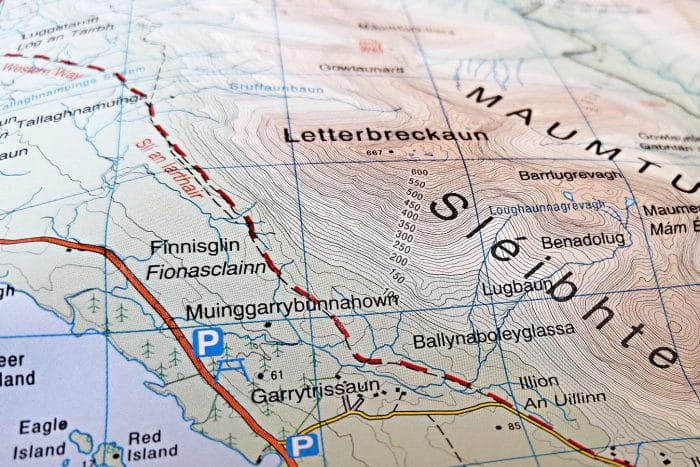
Map of the Western Way. – Photo credit www.nicholasgrundy.com
Forget to waterproof your boots
Too many times I’ve headed out the door for the day having forgotten for the second or third time running that I haven’t yet updated the layer of waterproofing on my boots. Whether it’s a spray or a rub-in coating, always remember to renew the seal on your footwear if they are made from a material or grade of leather that requires regular maintenance. It’s a good idea to set yourself a reminder to do this before each hiking season, say in the springtime, or if you can afford it, to buy a pair of boots that doesn’t need regular re-waterproofing.
Forget to check your boots before your hike
Similar to the last point, but somewhat different, is the idea of checking your boots for other general wear and tear that can lead to a loss of waterproofness. One of the main things to consider here is that old, well-worn boots (which us lovers of the outdoors often possess) can eventually begin to crack, split along the seems, and even pull away from the sole altogether. Now, if your boots end up pulling away from the sole at the back or along one side, you should probably just buy a new pair.
However, if you’re like me you’ll wind up putting this off for a very long time as you refuse to part with your favourite, well broken-in pair of hiking footwear. Yet the number of times I’ve headed off with cracked boots letting water in through the leather is quite laughable. And don’t throw away those boots just yet though. I’ve had success with past pairs of boots making my own repairs using fishing wire and even strong dental floss to mend split leather and broken seams. Even strong superglue and construction adhesive can temporarily mend a floppy sole if you need a quick fix.
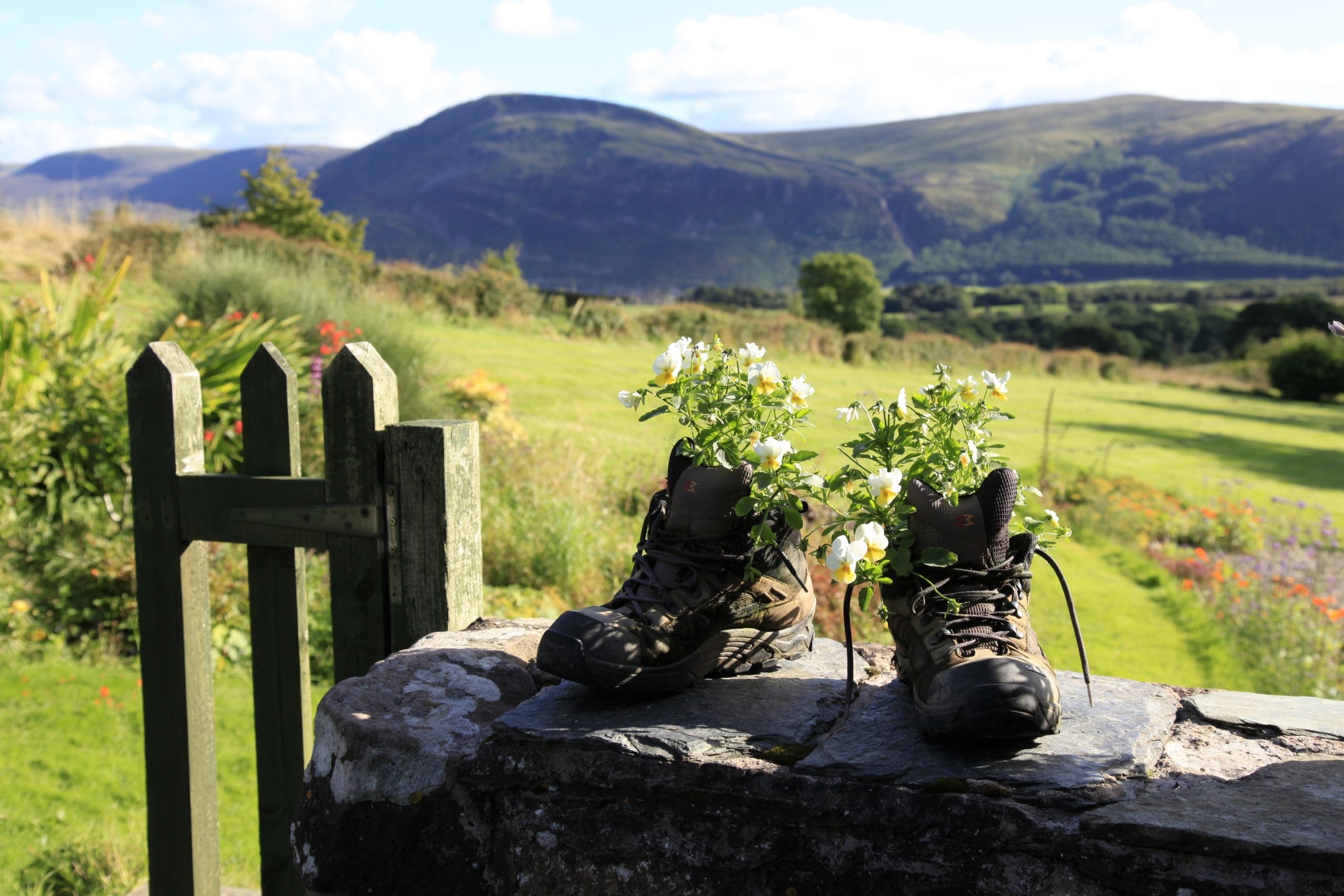
Forget to break in your boots beforehand
Another useful one to make sure of is to allocate ample time to wear in your new footwear before first embarking on a longer hike. I’ve unfortunately made the error of buying new boots right before a multi-day hike and suffered the consequences in the form of painful blisters. Even if time is a resource in which you are somewhat poor, there’s always an opportunity to first put those boots on for a few shorter periods here and there. You can even just wear them around the house or office while getting your normal day to day tasks done and the difference between doing this and doing nothing at all will be something that your feet will thank you for once you have those boots on for a full day or two straight.
Wear the wrong clothes when setting off
I learned my lesson on this one nearly ten years ago and haven’t yet made this mistake when hiking in Ireland, however it’s still a good one to bring up here. On a past trip to New Zealand we decided to make an overnight hike up to Mueller Hut, a mountain shelter overlooking Mount Cook, made famous by Sir Edmund Hillary, the first person to successfully ascend Mount Everest alongside Sherpa Tenzing Norgay. We mistakenly trusted the advice of the rookie park ranger in Mount Cook Village, who informed us that the entire route up to the hut was completely devoid of snow and ice at the time.
We later found out that they had just swapped out their route information boards at the ranger station from winter to summer conditions, a change made on the 1st of December each year. We were setting out on the 1st of December, and no one informed us that a freak late winter blizzard had just blanketed the entire ridge line in deep snow and thick sheets of ice. So, with the sun shining warm and bright down on the valley floor, I of course set off wearing shorts to ensure that I didn’t overheat on the steep ascent. Halfway up we reached the snowline, which was many hundreds of metres lower down than it was supposed to be for this time of year. As we rounded a spur and crested the ridge, we were met with a scene I’ll never forget.
My legs were suddenly and without warning blasted by tiny shards of ice and crystallised snow as gale force winds whipped up out of nowhere. My wife, fully covered in thick snow pants, jumped in front of me to shield my legs with each passing gust, as we were in no position for me to take my pack off and put my pants on! It took a good while for the stinging sensation to leave my legs after finally reaching the hut.
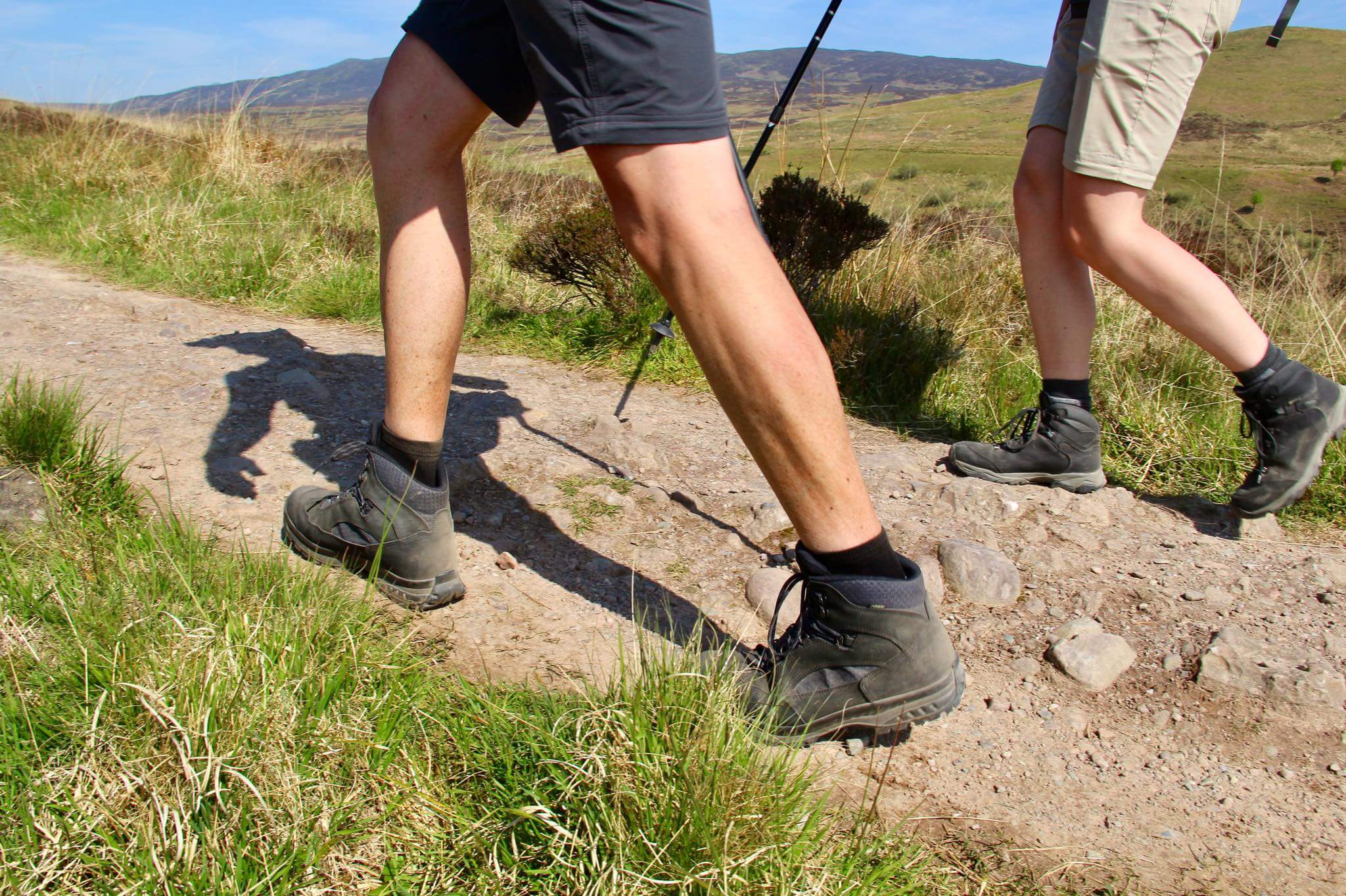
Accidentally follow an animal track
When hiking in Ireland it’s useful to learn the difference between a proper, waymarked hiking trail, and an animal track. In Ireland most such tracks are formed by domesticated livestock, namely sheep, whereas in other countries they are formed by wildlife such as deer, wild boar, etc. Unfortunately what I find is that sheep tracks in Ireland can all too often resemble manmade tracks very closely.
Both types of tracks feature a well-worn, narrow path, however sheep tracks are usually noticeably narrower due to the way in which sheep walk with their feet one after the other, like mountain goats. This is especially true along the sides of steeper slopes where horizontal flat surfaces are limited. Most importantly, remember to check for the track markers you are supposed to be following. It goes without saying, but sheep tracks in Ireland obviously won’t feature these – unless of course sheep have started erecting their own waymarkers without my knowledge!

Forget to pack insect repellent
This is a mistake I’ve promised myself to never make again. And once more, it’s definitely a mistake I made due to being an Australian who migrated to Ireland. I mean, surely after coping with the incessant desert flies of the Outback and the tyrannical mosquitoes in tropical Queensland, Ireland won’t have any sort of creepy crawlies to literally “get up your sleeves.” Right?
Wrong! During the key hiking season between April and September, many parts of Ireland can become blanketed in thick swathes of tiny, little black flying insects known as ‘midges.’ I’d never heard of the little critters upon first moving here, but friends soon warned me to take them seriously. “Surely not,” I thought, venturing down our back field to tidy up a fallen tree. After only a few minutes I was forced to take these guys seriously as they attempted to bite, sting and devour any piece of exposed flesh! And that was just in my backyard, let alone out in the remote valleys and bogs of the West of Ireland. Morale of the story: Pack the correct type of insect repellent before you head off. If you’re bringing your own bug spray from overseas, it’s also probably best to just make sure you buy the correct stuff upon your arrival into Ireland.
Pack unnecessary items
As I mentioned previously, thanks to my time in the Australian Army I have a problem with bringing too much stuff with me. Always prepared for any eventuality and survival situation right? Well, this isn’t really necessary in Ireland. Even when you feel nice and isolated as you take in the stunning views out over the Atlantic Ocean, the good news is that you’re never too far away from supplies. What’s more, many visitors to Ireland – especially those from latitudes closer to the equator such as Florida, Texas, southern California, northern Australia, and so on – are shocked by how long the days are in Ireland during our glorious summers.
Even if there’s a bit of rain and cloud cover here and there, you’re almost always guaranteed to get at least a good bit of sunshine. This is because from late May to late August, and in particular close to June 21st, the sun is above the horizon for 15, 16, and sometimes even 17 or more hours! In the very middle of summer the twilight period before and after the sun rises and sets last so long that there’s only a few hours of pure darkness between about midnight and 3 am. As such, you don’t always need to pack a head torch, flashlight, spare batteries and all of that other gear associated with the darkness of winter.
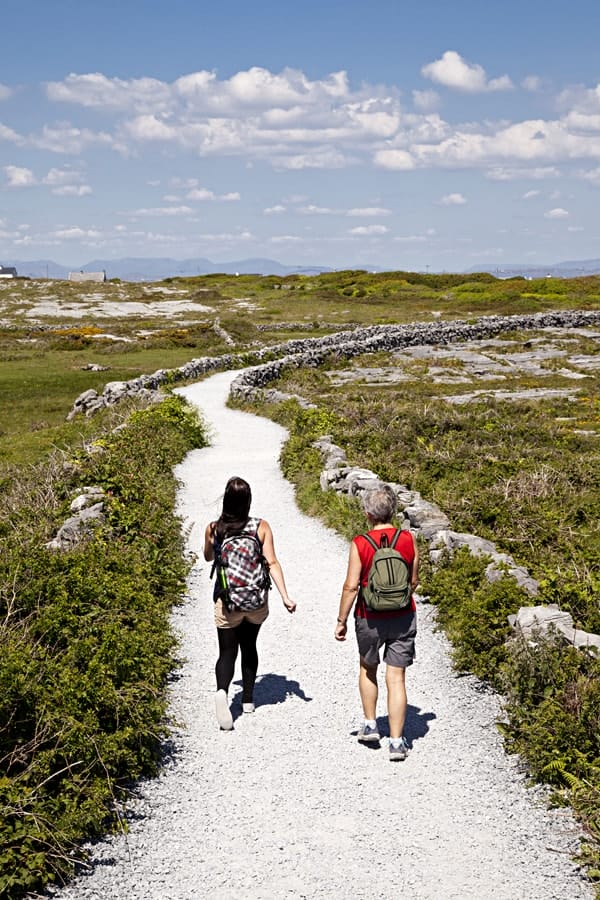
Hikers on the Aran Islands. – Photo credit www.nicholasgrundy.com
Hike on roads at night without lights and high-visibility jacket
This is not a problem at all when hiking during the endless summer days in Ireland. However, as you enter the winter months, and especially once daylight savings time ends between late October and late March, the nights can become exceptionally long and dark here. As such, if you are planning on hiking at night during the winter months, a flashlight and/or head torch with spare batteries are a must.
It’s also a good idea to bring a backup should you be hiking alone. However, what’s absolutely crucial is that you are well lit and wearing high-visibility clothing if you plan on following any of the country road walking routes in Ireland. Many of our hiking trails include sections along the local country roads, and it’s here that you must be careful in the dark of night. The roads can be surprisingly narrow, and as such it’s your own personal responsibility from a safety perspective that a passing motorist will be able to see you clearly and in time.
That’s all for this month, but remember to check back soon for the final 8 comedic tips about how to be a better hiker by learning from my mistakes. You can check out part 1 of this series here.
We hope that you enjoyed this hiking in Ireland guide. For more information on Ireland hiking tours, just get in touch.


